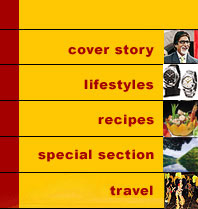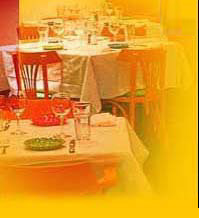


 A Saraswat Way Of Life
A Saraswat Way Of Life
Raj Salgaocar is a Gowd Saraswat Brahmin with a culturally rich and traditional background which naturally includes strong culinary influences. UPPERCRUST was priveleged to chat with Dipti and Raj at their ocean facing, top of the hill, weekend home at Dona Paula. The Salgaocars are Gowd Saraswat Brahmins. The Gowd Saraswat Brahmins who make up around 5% of Goa's population have had a tremendous impact on the socio-economic culture of Goa. The Gowd Saraswat Brahmins originally resided in the Saraswat river valley in North India and were vegetarian. When the river Saraswati had almost dried up, it is believed that Rishi Saraswati persuaded his disciples to eat fish in order to maintain strength to recite the stotras. Most of the Saraswats soon migrated to various parts of the country. One stream which had migrated to Bengal (Gowd) came via Vindhyas to Goa, a land they believe was especially created for them by Lord Parshuram, the sixth avatar of Lord Ram.  The Gowd Saraswats brought a new passion for food in Goa and used local produce and prepared them in innovative and delicious ways. Only the freshest and purest ingredients were used: whether fish, breadfruit or raw mango. Traditionally, the women only ate fish. Chicken and mutton were shunned which the men folk ate. Pork and beef were never eaten. The Gowd Saraswats brought a new passion for food in Goa and used local produce and prepared them in innovative and delicious ways. Only the freshest and purest ingredients were used: whether fish, breadfruit or raw mango. Traditionally, the women only ate fish. Chicken and mutton were shunned which the men folk ate. Pork and beef were never eaten. "In a way we are very spoilt in Goa with the clean air, pristine beaches , great food and the Goan way of life" says Raj Salgaocar. "My mother was an outstanding cook who learnt the art from her mother-in-law by observing her and improvisation. There were no recipes written down. All the spices were chosen based on the fresh sea food brought home, proportions of the masalas and freshly ground coconut decided by memory and instinct and the dishes then prepared. I must confess that the seafood of Goa has the most distinctive taste and we buy it fresh on a daily basis. We eat different kinds of seafood at different types of the year mackerel (bangda), sardines (talle), white sardines (velli), kingfish (viswan), bekti (chanak), Indian salmon (rawas), ladyfish (muddashi ), mullets (shevte), pearlspot (kalundar) etc. besides clams (tissario),  prawns (sungta), crabs (koolli), oysters (kalwa) and other shell fish. We prefer the smaller prawns which curry well and large brackish water "white" prawns which are often masala fried. We also love dried seafood like dried prawns from which we make kismoor or dried mackerels. Crabs in Goa are caught from the sea or river; but the river crabs are more delicious with lots of egg roe ( lakh) found frequently. I love the entire range of Goan sea food. Also our Goan rice especially the brown rice has a distinct aroma and goes brilliantly with spicy curry. Traditionally we add various seasonal fruits or vegetables grown locally which enhance the taste of the curry like raw mango, bimbal, hog berry (ambado), acrid lemon (tefal), drumstick (mashing), cocum (sola) etc". prawns (sungta), crabs (koolli), oysters (kalwa) and other shell fish. We prefer the smaller prawns which curry well and large brackish water "white" prawns which are often masala fried. We also love dried seafood like dried prawns from which we make kismoor or dried mackerels. Crabs in Goa are caught from the sea or river; but the river crabs are more delicious with lots of egg roe ( lakh) found frequently. I love the entire range of Goan sea food. Also our Goan rice especially the brown rice has a distinct aroma and goes brilliantly with spicy curry. Traditionally we add various seasonal fruits or vegetables grown locally which enhance the taste of the curry like raw mango, bimbal, hog berry (ambado), acrid lemon (tefal), drumstick (mashing), cocum (sola) etc". Food is very much a part of Goan life and continues to be a topic of hot discussion even among men folk who originally went to the market to buy fish. Saraswat food does not use any vinegar which was introduced by the Portuguese and used more by the Goan Catholic community to make vindaloo, sorpotel, balchao and other such preparations.  "Personally I love prawn balchao, chicken cafreal and mutton vindaloo which were introduced to Goa initially by the Portuguese but improved upon by the local converts and have become part of Goan life". "Personally I love prawn balchao, chicken cafreal and mutton vindaloo which were introduced to Goa initially by the Portuguese but improved upon by the local converts and have become part of Goan life". About Saraswat vegetarian food, Raj says, "Saraswats have a whole range of vegetarian food which is coconut based and eaten on all religious days and festivals. In Goa, Shivrak means vegetarian. We eat a wide variety of vegetables very local to Goa like colocassia stems (alloom), tender bamboo shoots (keell) and wild mushrooms (almi) in the monsoons, fiddlehead (ankoor), jackfruit, amaranth (tambdi bhajee) and many other such vegetables at different times of the year. Monday for most Hindus in Goa is vegetarian being the day of Lord Shiva and Lord Damodar. Saraswats also observe Thursday the day of Lord Dattatraya. Ganesh Chathurthi is the biggest festival in Goa where the entire family gets together in their ancestral family home to celebrate. For Diwali we eat different preparations of pounded rice (fou) like pounded milk rice (doodantle fou), buttermilk beaten rice (takantle fou), pounded jaggery rice (godache fou), etc. We also have Goan sweets like sweet rice (sakharbhat), mangannem, millet pudding (Nashni satwa), Rice vermicelli (Shirvoli) and sweet coconut milk, banana cakes (dhonas), etc."  Raj is married to Dipti, daughter of Kokilaben and Dhirubhai Ambani and has two children. Dipti, a Gujarati and a vegetarian loves Goan vegetarian food, though she still relishes her Gujarati food. Dipti says," I love the uddhamethi raw mango curry, mushroom xacuti, tambdi bhaji and ankur tonak. I have started eating prawns and clams. I love prawns in all forms - fried, curry and cutlets (dangars). My children Vikram and Isheta are true seafood lovers like their father and could eat seafood for lunch and dinner every day!!! They are studying abroad and one thing they truly miss is Goan food which no restaurant in the US can provide. Goa is also very cosmopolitan and has some great restaurants with very personalised service." Raj is married to Dipti, daughter of Kokilaben and Dhirubhai Ambani and has two children. Dipti, a Gujarati and a vegetarian loves Goan vegetarian food, though she still relishes her Gujarati food. Dipti says," I love the uddhamethi raw mango curry, mushroom xacuti, tambdi bhaji and ankur tonak. I have started eating prawns and clams. I love prawns in all forms - fried, curry and cutlets (dangars). My children Vikram and Isheta are true seafood lovers like their father and could eat seafood for lunch and dinner every day!!! They are studying abroad and one thing they truly miss is Goan food which no restaurant in the US can provide. Goa is also very cosmopolitan and has some great restaurants with very personalised service."No one expresses love for food better than Goa's poet-laureate Bakibab Borcar in his celebrated poem to Yama, Lord of Death: Please Sir, God of Death Don't make it my turn today Not today, Sir..... We have fish curry for dinner. |

Home Page